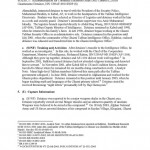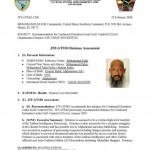 As of May 31, 2015, 5:00 PM, EST Qatar and the United States have agreed to an extension of detention.
As of May 31, 2015, 5:00 PM, EST Qatar and the United States have agreed to an extension of detention.
Sample detainee: Mohammed Zahir’s Guantanamo detainee assessment  Who is really deciding who does get released, to what transfer point, why and who approves? What are the conditions of release, is there money paid to the country of last destination? How long are they to stay in the last country of destination and under what conditions? If these people pose no threat, they why are the negotiations not for public release? If they pose no threat, then how come they are not released back to their home country? How come the Obama administration does not offer them refugee status in the United States? Here is a list of the detainees through 2006. Merely skim this list for names and country of origin. See a pattern? The Taliban 5 that were swapped for deserter Bowe Bergdahl are free from their Qatar Club Med fully vacation location, TODAY. What deal did the United States work with Qatar to monitor their future activities? Another secret. If this was such a great swap deal, then why did the White House not advise Congress 30 days prior to the swap, which is law? Do you believe this? (CNN)Senior administration officials said Friday that the U.S. is continuing to hold negotiations with the governments of Afghanistan and Qatar as a deadline to determine the fate of five Taliban figures released in a prisoner exchange with the U.S. looms. Qatar is willing to extend the agreement under exactly the same terms, but will not renegotiate the terms, the source said. The Americans are sending signals they want to add additional surveillance and more restrictions on their movement. “[Qatar] will keep them if both parties agree and if there are the same conditions of the old agreement,” the source said. “[Qatar is] not going to add other terms because [Qatar is] not going to make it more complicated for [themselves].” The source said that although U.S., Afghanistan and Qatar are the main parties, the Taliban do have a say and are welcome to stay in Qatar, noting the five have brought their families to Qatar and now total about 70 people among them. The source emphasized Qataris will not send them back to Afghanistan if the men don’t want to return to Afghan government control.
Who is really deciding who does get released, to what transfer point, why and who approves? What are the conditions of release, is there money paid to the country of last destination? How long are they to stay in the last country of destination and under what conditions? If these people pose no threat, they why are the negotiations not for public release? If they pose no threat, then how come they are not released back to their home country? How come the Obama administration does not offer them refugee status in the United States? Here is a list of the detainees through 2006. Merely skim this list for names and country of origin. See a pattern? The Taliban 5 that were swapped for deserter Bowe Bergdahl are free from their Qatar Club Med fully vacation location, TODAY. What deal did the United States work with Qatar to monitor their future activities? Another secret. If this was such a great swap deal, then why did the White House not advise Congress 30 days prior to the swap, which is law? Do you believe this? (CNN)Senior administration officials said Friday that the U.S. is continuing to hold negotiations with the governments of Afghanistan and Qatar as a deadline to determine the fate of five Taliban figures released in a prisoner exchange with the U.S. looms. Qatar is willing to extend the agreement under exactly the same terms, but will not renegotiate the terms, the source said. The Americans are sending signals they want to add additional surveillance and more restrictions on their movement. “[Qatar] will keep them if both parties agree and if there are the same conditions of the old agreement,” the source said. “[Qatar is] not going to add other terms because [Qatar is] not going to make it more complicated for [themselves].” The source said that although U.S., Afghanistan and Qatar are the main parties, the Taliban do have a say and are welcome to stay in Qatar, noting the five have brought their families to Qatar and now total about 70 people among them. The source emphasized Qataris will not send them back to Afghanistan if the men don’t want to return to Afghan government control. One of the Taliban 5: Mullah-Norullah Nori, Reasons for Continued Detention: Detainee is an admitted senior member of the Taliban and led troops against US and Coalition forces. Detainee was directly subordinate to Taliban Supreme Leader Mullah Omar, commanded Taliban forces in northern Afghanistan, and in late 2001, he was in charge of Taliban troops positioned near Mazar-e-Sharif. Detainee is wanted by the UN for possible war crimes including the murder of thousands of Shiites. Detainee is also associated with members of al-Qaida, Islamic Movement of Uzbekistan (IMU), Libyan Islamic Fighting Group (LIFG) and the Hezb-E- Islami Gulbuddin (HIG). His full history is here, this explains just who the United States was taking off the battlefield under the Bush administration. To read about the hearing Congress had on this Taliban 5 swap for a deserter, that document is here.
Further, here is Uruguay’s position of the 6 released detainees to took. There are growing concerns in some corners of the American government that six former Guantanamo Bay detainees freed by the Obama administration could pose a threat to the safety of U.S. personnel. Those detainees were sent to Uruguay in December. And in recent months, the U.S. Embassy in Montevideo has substantially expanded its defenses against a possible threat, according to three sources familiar with the matter.
The embassy has increased the number of guards present, as well as the size of the embassy’s Marine Guard detachment, adding two more men to the handful who were there previously. The embassy has also taken steps to heighten security for employees. All local hires have been ordered to park two to three blocks from the building so that embassy guards can conduct surveillance more easily over American cars and passengers parked nearby. Some local staff have taken that order as disregard for the safety of foreign nationals working at the embassy. Read the full story here. Repeat, if these released detainees pose no threat, then why?

